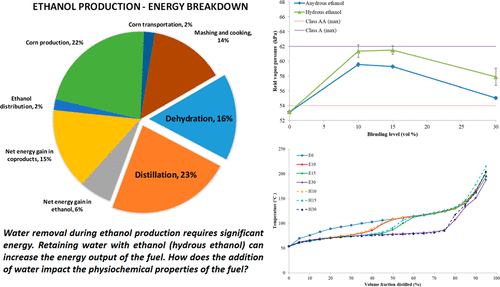当前位置:
X-MOL 学术
›
Ind. Eng. Chem. Res.
›
论文详情
Our official English website, www.x-mol.net, welcomes your
feedback! (Note: you will need to create a separate account there.)
Physiochemical Property Characterization of Hydrous and Anhydrous Ethanol Blended Gasoline
Industrial & Engineering Chemistry Research ( IF 3.8 ) Pub Date : 2018-08-01 , DOI: 10.1021/acs.iecr.8b01711 Saeid Aghahossein Shirazi 1 , Bahareh Abdollahipoor 2 , Jake Martinson 1 , Kenneth F. Reardon 1 , Bret C. Windom 2
Industrial & Engineering Chemistry Research ( IF 3.8 ) Pub Date : 2018-08-01 , DOI: 10.1021/acs.iecr.8b01711 Saeid Aghahossein Shirazi 1 , Bahareh Abdollahipoor 2 , Jake Martinson 1 , Kenneth F. Reardon 1 , Bret C. Windom 2
Affiliation

|
Water removal during the production of bioethanol is highly energy intensive. At the azeotropic point, the mixture can no longer be separated via fractional distillation, so expensive and energy intensive methods are required for further purification. Hence, there is an interest in using hydrous ethanol at the azeotropic point to improve the energy balance of ethanol fuel production. Currently there is a lack of available thermophysical property data for hydrous ethanol gasoline fuel blends. These data are important to understand the effect of water on critical fuel properties and to evaluate the potential of using hydrous ethanol fuels in conventional and optimized spark ignition engines. In this study, gasoline was blended with 10, 15, and 30 vol % of anhydrous and hydrous ethanol. The distillation curve, Reid vapor pressure, vapor lock protection potential, viscosity, density, haze and phase separation points, and lower heating value were measured for each blend, and the results were compared to ASTM D4814, the standard specification for automotive spark ignition engine fuels. The majority of the properties measured for the low- and midlevel hydrous ethanol blends are not significantly different from those of the corresponding anhydrous ethanol blends. The only differences observed between the hydrous and anhydrous fuels were in their viscosity and phase separation. The viscosity increased as the total water content increased, whereas the phase separation temperatures decreased with an increasing hydrous ethanol fraction. The results of this study suggest that hydrous ethanol blends may have the potential to be used in current internal combustion engines as a drop-in fuel and in future engine designs tuned to operate on fuels with high levels of ethanol.
中文翻译:

含水和无水乙醇混合汽油的理化性质表征
生物乙醇生产过程中的除水需要大量能源。在共沸点,不能再通过分馏分离混合物,因此需要昂贵且耗能大的方法来进一步纯化。因此,存在在共沸点使用含水乙醇以改善乙醇燃料生产的能量平衡的兴趣。当前,缺乏用于含水乙醇汽油燃料共混物的可用热物理性质数据。这些数据对于了解水对关键燃料性能的影响以及评估在常规和优化火花点火发动机中使用含水乙醇燃料的潜力非常重要。在这项研究中,将汽油与10、15、30%(体积)的无水和含水乙醇混合。蒸馏曲线,里德蒸气压,测量了每种混合物的汽锁保护电位,粘度,密度,雾度和相分离点以及较低的发热量,并将结果与汽车火花点火发动机燃料的标准规格ASTM D4814进行了比较。低级和中级含水乙醇共混物测得的大多数性能与相应的无水乙醇共混物的测量性能无显着差异。在无水和无水燃料之间观察到的唯一区别在于它们的粘度和相分离。粘度随着总水含量的增加而增加,而相分离温度随着含水乙醇分数的增加而降低。
更新日期:2018-08-02
中文翻译:

含水和无水乙醇混合汽油的理化性质表征
生物乙醇生产过程中的除水需要大量能源。在共沸点,不能再通过分馏分离混合物,因此需要昂贵且耗能大的方法来进一步纯化。因此,存在在共沸点使用含水乙醇以改善乙醇燃料生产的能量平衡的兴趣。当前,缺乏用于含水乙醇汽油燃料共混物的可用热物理性质数据。这些数据对于了解水对关键燃料性能的影响以及评估在常规和优化火花点火发动机中使用含水乙醇燃料的潜力非常重要。在这项研究中,将汽油与10、15、30%(体积)的无水和含水乙醇混合。蒸馏曲线,里德蒸气压,测量了每种混合物的汽锁保护电位,粘度,密度,雾度和相分离点以及较低的发热量,并将结果与汽车火花点火发动机燃料的标准规格ASTM D4814进行了比较。低级和中级含水乙醇共混物测得的大多数性能与相应的无水乙醇共混物的测量性能无显着差异。在无水和无水燃料之间观察到的唯一区别在于它们的粘度和相分离。粘度随着总水含量的增加而增加,而相分离温度随着含水乙醇分数的增加而降低。































 京公网安备 11010802027423号
京公网安备 11010802027423号